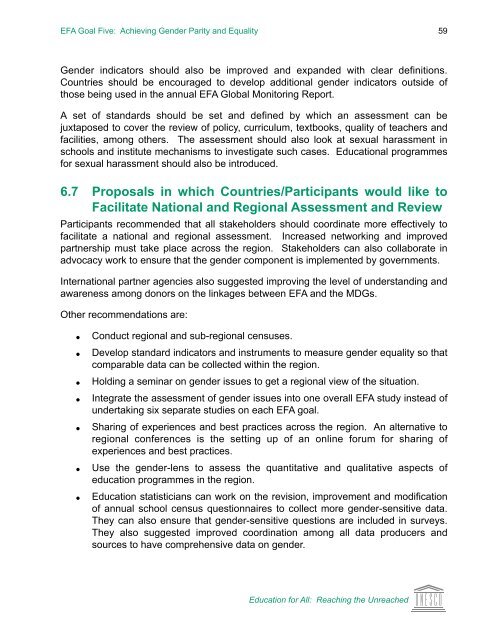Download - UNESCO Bangkok
Download - UNESCO Bangkok
Download - UNESCO Bangkok
- No tags were found...
Create successful ePaper yourself
Turn your PDF publications into a flip-book with our unique Google optimized e-Paper software.
EFA Goal Five: Achieving Gender Parity and Equality 59Gender indicators should also be improved and expanded with clear definitions.Countries should be encouraged to develop additional gender indicators outside ofthose being used in the annual EFA Global Monitoring Report.A set of standards should be set and defined by which an assessment can bejuxtaposed to cover the review of policy, curriculum, textbooks, quality of teachers andfacilities, among others. The assessment should also look at sexual harassment inschools and institute mechanisms to investigate such cases. Educational programmesfor sexual harassment should also be introduced.6.7 Proposals in which Countries/Participants would like toFacilitate National and Regional Assessment and ReviewParticipants recommended that all stakeholders should coordinate more effectively tofacilitate a national and regional assessment. Increased networking and improvedpartnership must take place across the region. Stakeholders can also collaborate inadvocacy work to ensure that the gender component is implemented by governments.International partner agencies also suggested improving the level of understanding andawareness among donors on the linkages between EFA and the MDGs.Other recommendations are:●●●●●●●Conduct regional and sub-regional censuses.Develop standard indicators and instruments to measure gender equality so thatcomparable data can be collected within the region.Holding a seminar on gender issues to get a regional view of the situation.Integrate the assessment of gender issues into one overall EFA study instead ofundertaking six separate studies on each EFA goal.Sharing of experiences and best practices across the region. An alternative toregional conferences is the setting up of an online forum for sharing ofexperiences and best practices.Use the gender-lens to assess the quantitative and qualitative aspects ofeducation programmes in the region.Education statisticians can work on the revision, improvement and modificationof annual school census questionnaires to collect more gender-sensitive data.They can also ensure that gender-sensitive questions are included in surveys.They also suggested improved coordination among all data producers andsources to have comprehensive data on gender.Education for All: Reaching the Unreached
















